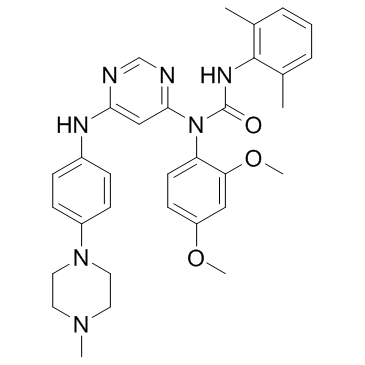1456858-58-4
| Name | hg-9-91-01 |
|---|---|
| Synonyms |
HY-15776
HG-9-91-01 Methanol, 1-[(2,4-dimethoxyphenyl)[6-[[4-(4-methyl-1-piperazinyl)phenyl]amino]-4-pyrimidinyl]amino]-1-[(2,6-dimethylphenyl)imino]-, (E)- N-(2,4-Dimethoxyphenyl)-N'-(2,6-dimethylphenyl)-N-(6-{[4-(4-methyl-1-piperazinyl)phenyl]amino}-4-pyrimidinyl)carbamimidic acid |
| Description | HG-9-91-01 is a potent and highly selective salt-inducible kinase (SIKs) inhibitor with IC50s of 0.92 nM, 6.6 nM and 9.6 nM for SIK1, SIK2 and SIK3 respectively. |
|---|---|
| Related Catalog | |
| Target |
IC50: 0.92/6.6/9.6 nM (SIK1/2/3)[1] |
| In Vitro | HG-9-91-01 inhibits a number of protein tyrosine kinases that possess a threonine residue at the gatekeeper site, such as Src family members (Src, Lck, and Yes), BTK, and the FGF and Ephrin receptors[1]. HG-9-91-01 demonstrates a strong correlation between the potency of SIK2 inhibition and enhanced IL-10 production. In agreement with these reports, pretreating BMDCs with HG-9-91-01, a recently described inhibitor of SIK1-3, along with several other kinases, results in concentration-dependent potentiation of zymosan-induced IL-10 production with an EC50 ~200 nM and a maximum effect similar to that observed with PGE2[2]. HG-9-91-01 has more than a 100-fold greater potency against SIKs than AMPK (IC50=4.5 μM) in a cell-free assay. HG-9-91-01 treatment dose dependently increased mRNA expression of Pck1 and G6pc and that effect is similar in cells treated with 4 μM HG-9-91-01 or 0.1 μM glucagon. Consistent with this observation, there is also a dose-dependent increase in glucose production following HG-9-91-01 treatment[3]. |
| Cell Assay | Bone marrow is harvested from femurs and tibias of C57BL/6 mice. Bone-marrow-derived dendritic cells (BMDCs) are differentiated DMEM supplemented with 2 mM GlutaMAX, 10% (vol/vol) FBS, Penicillin, Streptomycin, and 2% mouse granulocyte-macrophage colony-stimulating factor (GM-CSF)-conditioned media derived from murine L cells. Cultures are differentiated for 7 d and routinely analyzed for >90% CD11c (allophycocyanin (APC) anti-CD11c clone HL3) positivity by flow cytometry before use in experiments. Lentiviral transduction of bone marrow cultures is conducted by addition of 293T culture supernatants containing lentiviral particles encoding the CREB-dependent luciferase reporter construct or CRTC3 targeting or control shRNAs 1 d postisolation. Stable integration of lentiviral shRNA constructs is selected by addition of puromycin (3 μg/mL) on day 4 posttransduction. After 2 d, stably transduced BMDCs are released from selection and used in subsequent assays. Unless otherwise indicated, cells are treated for 2 d with PGE2 (5 μM) or HG-9-91-01 (0.5 μM) or an equivalent concentration of DMSO (≤0.5%) and then stimulated for 18 h with LPS (100 ng/mL), R848 (10 μg/mL), or Zymosan (4 μg/mL)[2]. |
| References |
| Density | 1.2±0.1 g/cm3 |
|---|---|
| Boiling Point | 779.7±70.0 °C at 760 mmHg |
| Molecular Formula | C32H37N7O3 |
| Molecular Weight | 567.681 |
| Flash Point | 425.3±35.7 °C |
| Exact Mass | 567.295776 |
| LogP | 4.57 |
| Vapour Pressure | 0.0±2.8 mmHg at 25°C |
| Index of Refraction | 1.630 |
| Storage condition | 2-8℃ |
